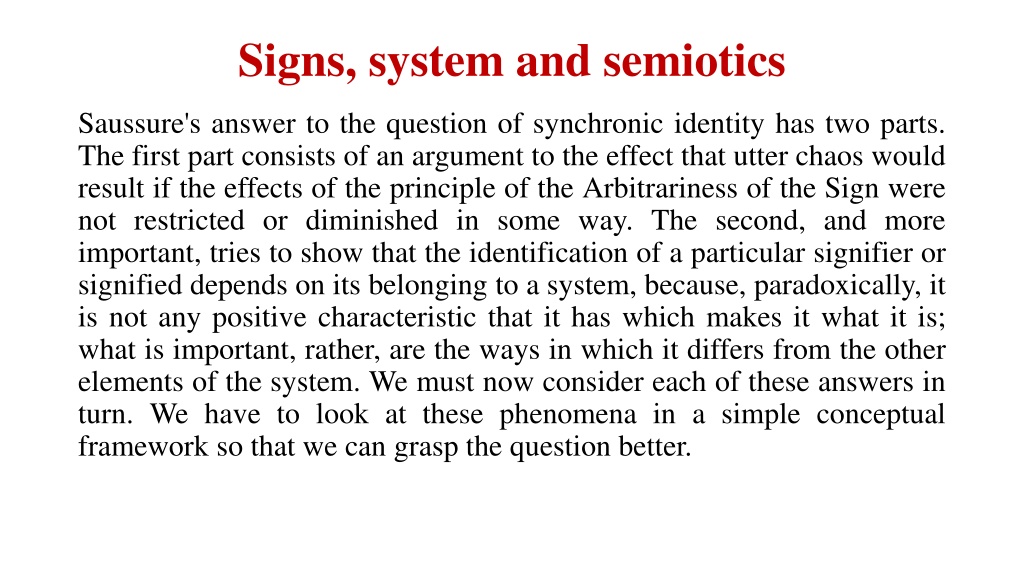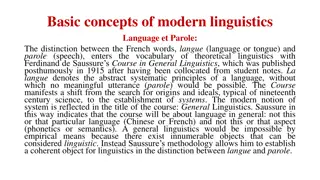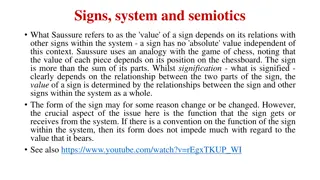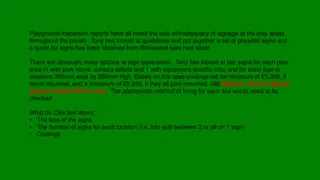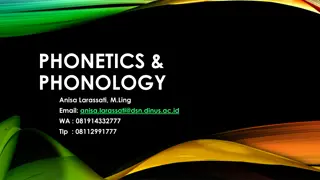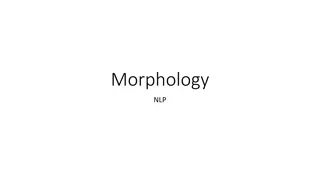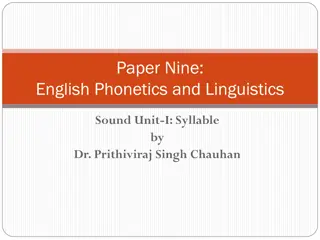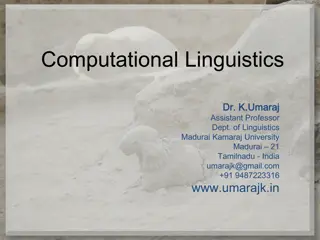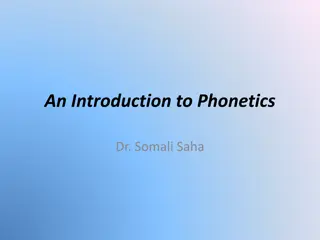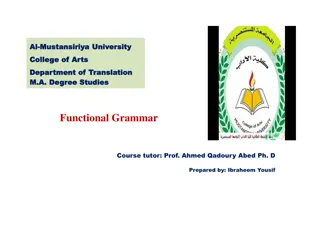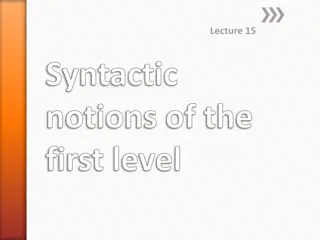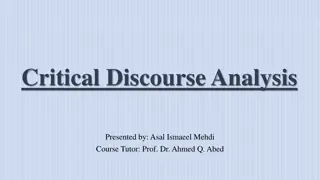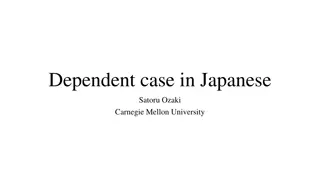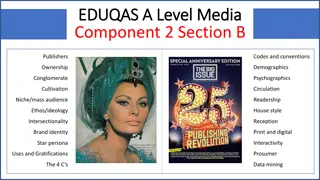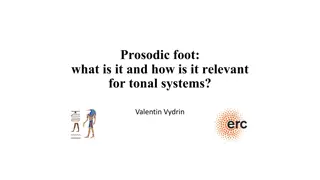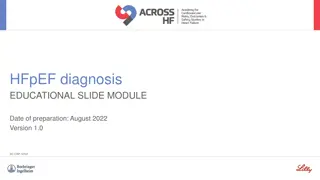Understanding Signs, Systems, and Semiotics in Linguistics
Saussure's theory of signs emphasizes the relationship between a signifier and a signified, highlighting the importance of belonging to a system of differences. Signs, as interpreted meaningful entities, play a crucial role in semiotics, shaping our understanding and communication. The concept of signs, as expounded by Saussure and Peirce, delves into the intricate layers of meaning-making through symbols and representations. The dynamics of signification and the potential for varied interpretations underscore the complexity and richness of human communication.
Download Presentation

Please find below an Image/Link to download the presentation.
The content on the website is provided AS IS for your information and personal use only. It may not be sold, licensed, or shared on other websites without obtaining consent from the author. Download presentation by click this link. If you encounter any issues during the download, it is possible that the publisher has removed the file from their server.
E N D
Presentation Transcript
Signs, system and semiotics Saussure's answer to the question of synchronic identity has two parts. The first part consists of an argument to the effect that utter chaos would result if the effects of the principle of the Arbitrariness of the Sign were not restricted or diminished in some way. The second, and more important, tries to show that the identification of a particular signifier or signified depends on its belonging to a system, because, paradoxically, it is not any positive characteristic that it has which makes it what it is; what is important, rather, are the ways in which it differs from the other elements of the system. We must now consider each of these answers in turn. We have to look at these phenomena in a simple conceptual framework so that we can grasp the question better.
Signs, system and semiotics We seem as a species to be driven by a desire to make meanings: above all, we are surely Homo significans - meaning-makers or homo semioticus. Distinctively, we make meanings through our creation and interpretation of 'signs'. Indeed, according to Peirce, 'we think only in signs'. Signs take the form of words, images, sounds, odours, flavours, acts or objects, but such things have no intrinsic meaning and become signs only when we invest them with meaning. 'Nothing is a sign unless it is interpreted as a sign', declares Peirce. Anything can be a sign as long as someone interprets it as 'signifying' something - referring to or standing for something other than itself. We interpret things as signs largely unconsciously by relating them to familiar systems of conventions. It is this meaningful use of signs which is at the heart of the concerns of semiotics. The two dominant models of what constitutes a sign are those of the linguist Ferdinand de Saussure and the philosopher Charles Sanders Peirce. Saussure offered a 'dyadic' or two-part model of the sign. He defined a sign as being composed of: a 'signifier' (signifiant) - the form which the sign takes; and the 'signified' (signifi ) - the concept it represents.
Signs, system and semiotics The sign is the whole that results from the association of the signifier with the signified. The relationship between the signifier and the signified is referred to as 'signification', and this is represented in the Saussurean diagram by the arrows. The horizontal line marking the two elements of the sign is referred to as 'the bar'. If we take a linguistic example, the word 'Open' (when it is invested with meaning by someone who encounters it on a shop doorway) is a sign consisting of: a signifier: the word open; a signified concept: that the shop is open for business.
Signs, system and semiotics A sign must have both a signifier and a signified. You cannot have a totally meaningless signifier or a completely formless signified. A sign is a recognizable combination of a signifier with a particular signified. The same signifier (the word 'open') could stand for a different signified (and thus be a different sign) if it were on a push-button inside a lift ('push to open door'). Similarly, many signifiers could stand for the concept 'open' (for instance, on top of a packing carton, a small outline of a box with an open flap for 'open this end') - again, with each unique pairing constituting a different sign.
Signs, system and semiotics Nowadays, whilst the basic 'Saussurean' model is commonly adopted, it tends to be a more materialistic model than that of Saussure himself. The signifier is now commonly interpreted as the material (or physical) form of the sign - it is something which can be seen, heard, touched, smelt or tasted. For Saussure, both the signifier and the signified were purely 'psychological'. They both were form rather than substance: A linguistic sign is not a link between a thing and a name, but between a concept and a sound pattern. The sound pattern is not actually a sound; for a sound is something physical. A sound pattern is the hearer's psychological impression of a sound, as given to him by the evidence of his senses. This sound pattern may be called a 'material' element only in that it is the representation of our sensory impressions. The sound pattern may thus be distinguished from the other element associated with it in a linguistic sign. This other element is generally of a more abstract kind: the concept.
Signs, system and semiotics Saussure was focusing on the linguistic sign (such as a word) and he 'phonocentrically' privileged the spoken word, referring specifically to the image acoustique ('sound-image' or 'sound pattern'), seeing writing as a separate, secondary, dependent but comparable sign system. Within the ('separate') system of written signs, a signifier such as the written letter 't' signified a sound in the primary sign system of language (and thus a written word would also signify a sound rather than a concept). Thus for Saussure, writing relates to speech as signifier to signified. Most subsequent theorists who have adopted Saussure's model are content to refer to the form of linguistic signs as either spoken or written. We will return later to the issue of the post-Saussurean 'rematerialization' of the sign. As for the signified, most commentators who adopt Saussure's model still treat this as a mental construct, although they often note that it may nevertheless refer indirectly to things in the world. Saussure's original model of the sign 'brackets the referent': excluding reference to objects existing in the world. His signified is not to be identified directly with a referent but is a concept in the mind - not a thing but the notion of a thing. Some people may wonder why Saussure's model of the sign refers only to a concept and not to a thing. An observation from the philosopher Susanne Langer (who was not referring to Saussure's theories) may be useful here. Note that like most contemporary commentators, Langer uses the term 'symbol' to refer to the linguistic sign (a term which Saussure himself avoided): 'Symbols are not proxy for their objects but are vehicles for the conception of objects... In talking about things we have conceptions of them, not the things themselves; and it is the conceptions, not the things, that symbols directly mean. Behaviour towards conceptions is what words normally evoke; this is the typical process of thinking'. She adds that 'If I say "Napoleon", you do not bow to the conqueror of Europe as though I had introduced him, but merely think of him .
Signs, system and semiotics Thus, for Saussure the linguistic sign is wholly immaterial - although he disliked referring to it as 'abstract'. The immateriality of the Saussurean sign is a feature which tends to be neglected in many popular commentaries. If the notion seems strange, we need to remind ourselves that words have no value in themselves - that is their value. Saussure noted that it is not the metal in a coin that fixes its value. Several reasons could be offered for this. For instance, if linguistic signs drew attention to their materiality this would hinder their communicative transparency. Furthermore, being immaterial, language is an extraordinarily economical medium and words are always ready-to-hand. Nevertheless, a principled argument can be made for the revaluation of the materiality of the sign, as we shall see in due course. Saussure noted that his choice of the terms signifier and signified helped to indicate 'the distinction which separates each from the other'. Despite this, and the horizontal bar in his diagram of the sign, Saussure stressed that sound and thought (or the signifier and the signified) were as inseparable as the two sides of a piece of paper. They were 'intimately linked' in the mind 'by an associative link' - 'each triggers the other'. Saussure presented these elements as wholly interdependent, neither pre-existing the other. Within the context of spoken language, a sign could not consist of sound without sense or of sense without sound. He used the two arrows in the diagram to suggest their interaction. The bar and the opposition nevertheless suggests that the signifier and the signified can be distinguished for analytical purposes. Poststructuralist theorists criticize the clear distinction which the Saussurean bar seems to suggest between the signifier and the signified; they seek to blur or erase it in order to reconfigure the sign or structural relations. Some theorists have argued that 'the signifier is always separated from the signified... and has a real autonomy , a point to which we will return in discussing the arbitrariness of the sign. Commonsense tends to insist that the signified takes precedence over, and pre- exists, the signifier: 'look after the sense', quipped Lewis Carroll, 'and the sounds will take care of themselves' (Alice's Adventures in Wonderland, chapter 9). However, in dramatic contrast, post-Saussurean theorists have seen the model as implicitly granting primacy to the signifier, thus reversing the commonsensical position.
Signs, system and semiotics Louis Hjelmslev used the terms 'expression' and 'content' to refer to the signifier and signified respectively. The distinction between signifier and signified has sometimes been equated to the familiar dualism of 'form and content'. Within such a framework the signifier is seen as the form of the sign and the signified as the content. However, the metaphor of form as a 'container' is problematic, tending to support the equation of content with meaning, implying that meaning can be 'extracted' without an active process of interpretation and that form is not in itself meaningful. Saussure argued that signs only make sense as part of a formal, generalized and abstract system. His conception of meaning was purely structural and relational rather than referential: primacy is given to relationships rather than to things (the meaning of signs was seen as lying in their systematic relation to each other rather than deriving from any inherent features of signifiers or any reference to material things). Saussure did not define signs in terms of some 'essential' or intrinsic nature. For Saussure, signs refer primarily to each other. Within the language system, 'everything depends on relations'. No sign makes sense on its own but only in relation to other signs. Both signifier and signified are purely relational entities. This notion can be hard to understand since we may feel that an individual word such as 'tree' does have some meaning for us, but its meaning depends on its context in relation to the other words with which it is used.
Signs, system and semiotics Together with the 'vertical' alignment of signifier and signified within each individual sign (suggesting two structural 'levels'), the emphasis on the relationship between signs defines what are in effect two planes - that of the signifier and the signifier. Later, Louis Hjelmslev referred to the planes of 'expression' and 'content'. Saussure himself referred to sound and thought as two distinct but correlated planes. 'We can envisage... the language... as a series of adjoining subdivisions simultaneously imprinted both on the plane of vague, amorphous thought (A), and on the equally featureless plane of sound (B)'. The arbitrary division of the two continua into signs is suggested by the dotted lines whilst the wavy (rather than parallel) edges of the two 'amorphous' masses suggest the lack of any 'natural' fit between them. The gulf and lack of fit between the two planes highlights their relative autonomy. Whilst Saussure is careful not to refer directly to 'reality', Fredric Jameson reads into this feature of Saussure's system that 'it is not so much the individual word or sentence that "stands for" or "reflects" the individual object or event in the real world, but rather that the entire system of signs, the entire field of the langue, lies parallel to reality itself; that it is the totality of systematic language, in other words, which is analogous to whatever organized structures exist in the world of reality, and that our understanding proceeds from one whole or Gestalt to the other, rather than on a one-to-one basis .
References Holcroft, David. 1991. Saussure, Signs, System andArbitrariness. Cambridge: CUP. http://visual-memory.co.uk/daniel/Documents/S4B/sem02.html by Daniel Chandler.
